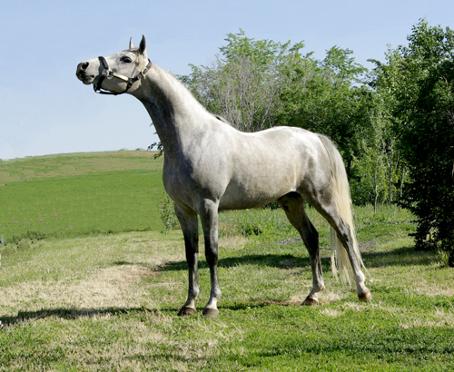
Comar Gai Rifraff
Pedigree Stats
Comar Gai Rifraff
Foals
Pedigree Stats
Comar Gai Rifraff is a
classic Crabbet silver stallion standing 14.2hh. In his limited show career, he
was presented in 2006 at the Utah Autumn Classic Region 7 show and placed 2nd
in the Arabian Stallion Breeding, and 2nd in the Arabian Stallion Breeding AT. While
at home Comar Gai Rifraff is used as
a ranch horse working cows and giving children rides. He is known to be a
broodmare sire producing outstanding daughters with excellent legs and minds.
His measurements are 8 inch cannons, 58 inches tall, and a 69 ½ inch heart
girth.
Comar Gai Rifraff's sire, LA Shaman,
is Champion of many northwest Halter, Native Costume, and Driving classes. He
was described as being a creature to behold. His beauty and charisma caused a
person to stop in their tracks, and even forget to breathe.
LA Shaman's sire, Gai Parada+++/ is the only stallion to
ever win a National Championship in Performance prior to a National
Championship in Halter. He is 1974 Canadian National Champion Pleasure Driving,
1974 US National Champion Pleasure Driving, 1975 Canadian National Top 10
Stallion, and 1977 US National Champion Stallion. Gai Parada+++/ is a
Legion of Supreme Honor and Supreme Merit award winner. Gai Parada+++/
was foaled at Gainey Fountainhead Arabians in Owatonna, MN. He did some growing
up at the Minnesota ranch before being sent to the Gainey ranch in Santa Ynez,
CA. Each time Mr. Gainey looked the colt over, he was even more sure he had
made the right decision to own him. Gai Parada+++/ pleased his artist's
eye and fit his ideal of extreme refinement, intelligence, delightful disposition,
elegance, and an exciting overall desert type. These qualities are still
cherished today by breeders who continue to utilize the Gai Parada+++/
blood. Sterling White, who trained and showed Gai Parada+++/ to his 3
National Championships, found him to be willing and responsive. Parada quickly
figured out exactly what was expected of him, and then tried very hard to
perform. "The communication between us became so sensitive that I could
just look at him and he knew what I wanted," Sterling recalls. They
started with performance training; Pleasure Driving turned out to be his forte.
Sterling remembers conditioning him in the buggy six miles per day, six days a
week, as part of his Driving training. In the show ring, judges concurred with
Mr. Gainey's assessment of Gai Parada+++/, as he won championships and
reserves in Pleasure Driving and English Pleasure. When Gai Parada+++/
was six, he impressed both the judges and the crowds at the 1974 US and
Canadian Nationals, and he took home 2 National Championship Pleasure Driving
titles. Daniel J. Gainey took over the operation of Gainey Fountainhead
Arabians in 1975 when his father became ill. Dan recalls, "I just knew Gai
Parada+++/ was a great horse, and soon after I took over, I decided he was
good enough that we should put him on the campaign trail. He ranked up a slew
of Championships and Reserves and finished off 1975 as a Canadian National Top 10
Stallion. In 1977, Lady Anne Lytton judged him Supreme Horse of the Minnesota
All-Arabian Show. And sure enough, he went all the way, becoming the 1977 US
National Champion Stallion. With 3 National Championships, Gai Parada+++/
retired to the Santa Ynez ranch to further his career as a breeding stallion.
This is where Parada really left his mark on the Arabian world. 6 Parada foals
were born in 1972 -- 3 colts and 3 fillies -- 4 of them bred by Daniel C.
Gainey. He tried Parada with 4 of his choice mares: Gai-Gay-Ferzona (Ferzon
x Arachne by Desmoin), Gavrelle (Ferzon x Gajala
by *Raffles), Galatia (*Royal Diamond x Galata by Ferneyn),
and Ferzona (Ferzon x Raffwe by Raffey). Marianna
Hannah of Mountain Center, CA, sent her Comet daughter *Pallada
(x Pandora by Wielki Szlem), and Mr. and Mrs. Raymond D. Anderson
of Rancho Palos Verdes, CA, sent Giralda (Regis x Joraba
by Al Farabi). 5 foals were born in 1973, 12 in 1974, 21 in 1975, and 37
in 1976. The numbers increased each year thereafter. In his lifetime Gai Parada+++/ sired 459 foals.
Gai Parada+++/ was sired by the great stallion Ferzon.
Ferzon was bred by Frank McCoy and foaled at the same time as Fadjur on
the McCoy Ranch. McCoy listed both stallions for sale with Fadjur's price at
$700 and Ferzon's price at $10,000, not dreaming anyone could come up
with that kind of money during that time. McCoy then showed Ferzon in
1953 at the Palm Desert, CA First Annual All Arabian Show to Reserve Champion
Stallion. At that same show Ferneyn, Ferzon's sire, took Grand
Championship. Moneyna, the dam of Ferneyn, was named
Reserve Champion Mare, while Hasa, a half-sister to Ferneyn by Ferseyn,
was the Grand Champion Mare. That same year Ferzon also won the Long
Beach, CA Yearling Colt Championship, San Diego, CA Desert Arabian Association
Yearling Colt Championship (again he placed 2nd to his own sire Ferneyn
in the Stallion Championship). In August of 1953, Ferzon was Reserve
Champion Yearling Colt with Fadjur placing 4th. In September of 1953 Ferzon
was the Champion Yearling Colt at the Los Angeles County Fair. Then came Daniel
Gainey, Sr, with $10,000 to purchase Ferzon and to produce a distinctive
look to Arabians that many people now call the Gainey-look.
Gai Parada+++/'s granddam, Fersara, was an exceptionally beautiful dapple grey mare. She was Pacific Coast Champion
Mare 1952, 1953 and Reserve Champion Mare 1954. Fersara was never out of the ribbons when shown, in 27
Classes she had 21 Blues. She was 3 time Grand Champion at the Pomona Fall Show, and the permanent Winner of the Kellogg Challenge Trophy. Fersara was considered The Champion Mare, and
was Always The Horse To Beat.
Comar Gai Rifraff carries many
lines to Azraff. Azraff was a sire of numerous winners including Comar
Bay Beau+++ out of Rose Of Mirage (1968 Canadian National Champion
Stallion and 1972 Canadian Reserve National Champion Western Pleasure); Camiraff++
out of Veishea (1969 US Reserve Champion Futurity Colt); Galizon
out of Gay-Rose (1969 US National Champion Stallion); Lea Baron+
out of Lea Geymette (1973 US National Champion Futurity Colt); AZA
Destiny out of Bint Bass Hisan (1981 Canadian Reserve National
Champion). Azraff was grandsire of Gai Parada+++/ by Ferzon
out of the Azraff daughter Azleta. Extensive list of Top 10
Winners: Adios+++ out of Rose-Of-Cherry; AZA Destiny; Azrhand
out of Handeyna; Banouz out of Nejd Banou; Bolsoya
Bachelor out of Rapanzel; Camiraff++; Comar Bay Beau+++;
Comar Bay Brummel++ out of Rose Of Mirage; Comar Dorrah
out of Rafleymira; Comar Garnet out of Rafleymira; Dar
Es Salaam out of Al-Marah Indra; Gai-Apache out of Ga-Rageyma;
Gai-Gay-Rose out of Gay-Rose; Galizon; Gay-Rouge
out of Gay-Rose; Kanadea out of Karin; Kharaff out
of Kharasaba; Marqeza out of Marjura; Mirraff out
of Mirzona; and Rose Of Azraff out of Rose Of Comar.
LA Shaman's dam Arifa Beau Azja, was the daughter of Bay
Rouge, a son of Gay-Rouge. Gay-Rouge, sired by Azraff,
was a Regional Top 10 in Pleasure Driving. Arifa Beau Azja's dam Beau
Heiress, is a daughter of Comar Bay Beau+++. Comar Bay Beau+++
was 1968 US National Champion Stallion, Reserve US National Champion Western
Pleasure, and was a Regional Champion in English Pleasure. Comar Bay Beau+++ was a Legion Of Supreme Merit award achiever.
Azraff's granddam, *Rifala, was both
an English and American Champion. She won several times in England and was Champion
mare at the National Arabian Show in Nashville, Tenn., in 1933. *Rifala
was also registered in the Jockey Club book as No. 5465
Comar
Gai Rifraff carries many lines to the
Crabbet stallion *Raffles. *Raffles was bred by Crabbet Arabian
Stud, Sussex, England, was imported from England to US in 1932 by Roger A.
Selby, Portsmouth, Ohio. (*Raffles was a gift from Lady Wentworth
to the Selby children, as he was believed to be sterile). In 1937, at age 11,
he was brought back to fertility by the Selby Stud Manager, Jimmy Dean and his
wife, Thelma, primarily through exercise. In 1949, when he was 23, *Raffles
was nearly lost to the breed when he broke a hind leg above the hock. Jimmy
Dean and his son, Pete, rigged a special sling that supported the stallion
enough to let the leg heal. The prepotency of the *Raffles type (Ali
Pasha Sherif type - classy, bold motion, density of bone and stamina) fixed
Arabian type for American breeders for generations. By 1981, 65 percent of the
US National Champions and Reserves had one or more crosses to *Raffles.
Comar Gai Rifraff carries multiple lines to Skowronek through both daughters and
sons, one of great note is *Raseyn. *Raseyn was the first
stallion by Skowronek to come to the US. He was a regular feature in the
Kellogg Sunday Show, being trained first as a jumper, then for five-gates as
which he was fairly fast at the rack, though not quite with the speed and form
of a Saddlebred. He had a natural slow gait, which he performed with style, and
a slow and graceful canter. *Raseyn was Champion Arabian at the Los
Angeles County Fair in 1933 and Champion Arabian Stallion at the Los Angeles
National Horse Show. He maintained his beautiful dark dappling for many years
and the white of his coat had the silvery sheen so typical of the Skowronek
horses. *Raseyn lived out the last years of his life with Alice Payne at
her Asil Ranch near Chino, California, and died there following a stroke on May
19, 1952. He was 29 years old at the time of his death.
Comar Gai Rifraff has several lines to *Mirage
as well. Roger Selby’s main purchase in 1930 was *Mirage, an
imported grey stallion of the Seglawi Jedran Dalia strain, the most prized of
the Seglawi strains. Lady Wentworth described him as ‘a very showy good horse.
Excellent legs, splendid quarters and fine front. Very good in saddle, but too
bouncing for English taste as he gets English riders off.’ But this was not the
reason *Mirage was sold. Weatherbys had by now closed their Stud Book to
new imports and although Lady Wentworth tried to persuade them to accept *Mirage,
she was unsuccessful and therefore had no option but to sell him. Margaret
Lindsley Warden said of *Mirage: “now rated by many experts as the most
perfect specimen of the ancient elite or classic type in America…He stands a
scant 14.2hh, a sturdy model with the characteristic refinements of the best of
his breed. His head is a glory and his great eyes express high but gentle
spirit and gracious personality.” *Mirage was English Champion at the
Richmond Royal Show 1926, and American Champion at the National Arabian Show,
Nashville, TN 1934, at the age of 25. A most unique honor for a horse of such
remarkable age. Only one other horse, Mr. Selby’s mare Champion *Rifala, holds
the same record of being both a British and American Champion.
One of these lines to *Mirage is
through his son Rifage. Rifage drove cattle on the Van Vleets’
Lazy VV Ranch near Boulder, Colorado, at an elevation of 8,600 feet. Rifage
was said to be small, but with the ruggedness and grace of tens of hundreds of
generations of pure Arabian breeding behind him…Rifage weighs 850
pounds. Frequently, his rider and equipment will weigh 250 or 275 pounds, or
one third of gallant Rifage’s own poundage. He doesn’t falter–he doesn’t
stumble on that trail. When the pack train stops to “blow” in the rare air, Rifage
disdains the opportunity to catch his breath. When Rifage wasn’t out
riding the range, he was used in the breeding shed, siring a number of National
winners, including Rominna out of Dominica, US National Champion Mare, and US National
Top 10 winners Rishima out of Ishmia, Shihada out of Sahalli, and Sulyman out of Ishmia.
Comar Gai Rifraff's dam
is Maur Kemaal. Maur Kemaal is a Blue Star, Asil, Al Khamsa mare,
Tail Male: Jamil El Kebir (APK), Tail Female: *Al Hamdaniah. She is 15hh
weighing approximately 900lbs, and with the finest, most perfect legs ever
witnessed on an Arabian. Maur Kemaal
is a true desert mare fearlessly taking her rider through all kinds of terrain,
never batting an eye at where she is asked to go. She has true courage,
protective, a real desert Arabian mare. She is currently competing
in Endurance placing well with perfect health scores and being awarded Best
Condition. Maur Kemaal is also
training in Dressage. She has produced talented
Endurance horses such as Fadila Rajamaal and Kashmirii Fadmar, both by Kioraja. Kashmirii
Fadmar in her first two races came in 4th against seasoned horses and 2nd
place with an even more seasoned race group respectively. Fadila Rajamaal's
first foal, DSZ Weayaya (by the Endurance producing stallion Muscastar
Son) was purchased to be used as a foundation broodmare for the Chaney
Endurance Arabians herd, as well as acquiring many Endurance miles herself.
Maur Kemaal is linebred to the desert horses *Fadl,
*Turfa and Sirecho. *Fadl was bred by Prince Mohammed
Ali, Manial Stud, Egypt. Imported from Egypt to US in 1932 by Henry B. Babson,
Chicago, Illinois. Sire of 74 registered purebred Arabian foals (34 of which
were Straight Babson Egyptians). The stallion *Fadl was used as a Polo Pony
and as an Endurance mount, besides being a successful show ring competitor in
both Halter and Performance, as well as working on the farm pulling the feed
wagon and manure spreader. Modern Arabian breeding owes much to the Babson
Egyptian imports. The breed’s all-time leading sire of Champions, Afire Bey
V, traces to the Babson stallion *Fadl, as do US National Champion
Stallions and influential sires Khemosabi++++// and Ali Jamaal,
multi-National Champion Park Aequus+/, *Simeon Shai+ (the only
stallion to ever be named US and Canadian National Champion Stallion and World
Champion Stallion), multi-National Champion Dressage El Bahim Halawa+,
and multi-National Champion English Pleasure Empress Of Bask, to name
just a few prominent horses who carry the Babson influence. 11 of *Fadl's
get produced National winners. The 6 *Fadl sons who have sired National
winners are: Fa-Serr out of Bint Serra I, Fabah out of Bint Bint Sabbah, Ibn Fadl out of *Turfa, Fa-Turf out of *Turfa, and Fadheilan out of *Kasztelanka
(sire of twice US Reserve National Champion Stallion Fadjur, one of the
most influential stallions in American Arabian breeding in the twentieth
century). *Fadl's National-winner producing daughters are Arafay out of Arabu,
Fa-Rahna out of Yatana, Dinah out of Fetyszia, Faaba out of Bint Bint Sabbah, and Turfara out of *Turfa. *Turfa was bred by the Saudi Royal Family (His Majesty
King Ibn Saoud) in the Royal Stud at Khorma, Nejd - Central (Saudi) Arabia.
Strain: Kuhaylat al-Ajuz, from the stud of Al Khorma in Saudi Arabia. She was
presented to King George VI of England as a coronation gift in 1937. Henry B.
Babson acquired her from the Prince of Wales and imported her into the US in
1941.
*Fadl was by Ibn Rabdan,
one of the most popular and heavily used stallions in Egypt. Carl Raswan
considered Ibn Rabdan as a "World Champion" type. Jack
Humphreys, who selected Arabians in Egypt for W.R. Brown, described Ibn
Rabdan as "almost perfect". *Fadl's dam, Mahroussa,
was epitomized as one of the most beautiful mares of her time. Mahroussa
was the daughter of Mabrouk Manial and Negma, both classic
Arabians of exceptional quality. Mahroussa also produced such
horses as *Zarife by Ibn Samhan, *HH Mohamed Alis Hamida by *Nasr, *HH Mohamed Alis
Hamama by Kawkab, and *Maaroufa by Ibn Rabdan, *Fadl's full sister.
Sirecho was regarded by Carl Raswan as having gone
down in American-Arabian history as one of the important foundation sires. Also
stating that he is one of the few who have become responsible for salvaging the
completely PURE Arabian in America from extinction. Because of his acquisition
by Mrs. Ott, Sirecho became one of
the few sources of Straight Egyptian lines which remains an outstanding
outcross for most pedigrees in which more popular Egyptians were used far more
frequently and far less judiciously. He was not stood at public stud, Mrs. Ott
handpicked the mares bred to him resulting in a relatively small, but high
quality band of foals. A family of remarkable longevity, they are also highly
prolific, still producing easily into their late twenties. As beautiful as they
are athletic, the Sirecho
descendants speak for themselves: Joramir out of Fad Roufa
1968 US Top 10 English Pleasure and Native Costume, 20 Class A Halter and
Performance Championships; Jora Honey Ku++ (Joramir X Hatties Honey Ku)
1978 Canadian National Champion; VP
Kahlua+ (Jora Honey Ku++ X Kahlette) 1984 US and Canadian National Champion Mare; AK Sirhalima (*Ansata Ibn Halima++ X Sirhabba) Australian Leading Sire of Champions; Anchor Hill Halim (Hadbah X Silima) German multi Champion
and Endurance winner; Anchor Hill Omar (Char Echo X Anchor Hill Bint Gamila)
South African National Champion; Anchor
Hill Annah (Char Echo X Anchor Hill Hannah) US Top 10 Trail Champion; Ses
Bint Khebira (Ali Reshan X Raadin Khebira) Egyptian Event and Salon Du Cheval winner; *Simeon Shai+ (Raadin Royal Star X Simeon Safanad) US and Canadian National Champion Stallion, along with
such notables as Glorieta Gazaal
(Ansata Abu Nazeer X Glorieta Gambolia) and Akid Geshan (Nabiel+/ X Akid Hanalei). The black Sirecho granddaughter Shar Gemla (Negem X Sirhabba) is influential in pedigrees
of many black show champions of the Arabians of “The Black Stallion” movie
fame.
Sirecho’s dam, *Exochorda
(also known as Leila II and Marquita in Egypt) was known as a
beautiful, powerfully built, and exceedingly correct Purebred Arabian racing
mare. Much controversy swirls around her importation, birth date, and even her
entries in the RAS. Few, if any, can deny the impact she had on the Arabian
breed. *Exochorda was a Saqlawi mare
born in Egypt in the early part of the 1920’s. A demure mare, she stood only
14.2 hands high and weighed about 825 pounds. Her sire, the stallion known as Aiglon, and her dam, Leila I, were both pure desertbreds who
had been imported into Egypt directly from the Arabian desert by private
breeders. According to Carl Raswan, both parents were acquired through the
Argheyl Muhammed Ibn Marzuki of Bureyda Quasim. All 3, Aiglon, Leila I and Leila II, raced in the Purebred Division
on the Cairo racetrack, under the scrupulous eye of the Jockey Club Committee,
headed by Dr. Branch. Raswan stated that Prince Kemal El Dine “used to call *Exochorda (Leila II) the female counter-part of Mesaoud”.
Sirecho’s sire, *Nasr,
was imported into the US in 1932 by Mr. W.R. Brown. *Nasr was bred by Prince Mohammed Ali. He was a stunning white bold
and powerful stallion. *Nasr had a
remarkable racing career in Egypt prior to his importation. Standing 15 hands
high and weighing 1,000 pounds, he is recorded as having a girth of 70 inches
with 7.5 inches of bone. His foals were exported to countries all over the
world, including England, Brazil, Guatemala, Columbia and Venezuela.
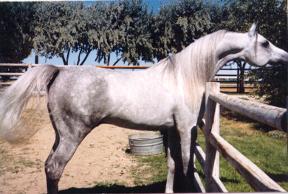
LA Shaman
(Gai Parada+++/ X Arifa Beau Azja)
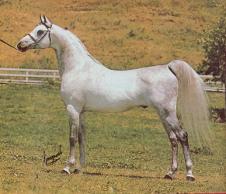
Gai Parada+++/
(Ferzon X Azleta)
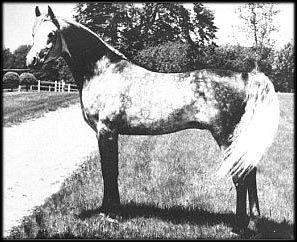
Ferzon
(Ferneyn X Fersara)
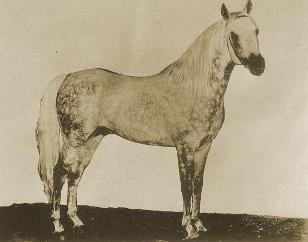
Ferneyn
(Ferseyn X Moneyna)
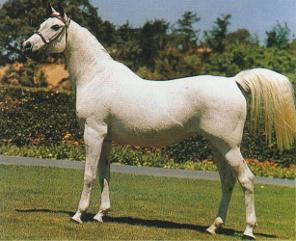
Azleta
(Azraff X Phleta)
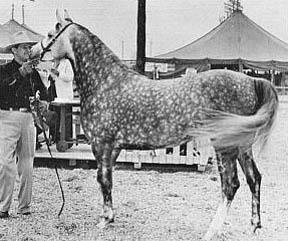
Fersara
(Ferseyn X Bint Sahara)
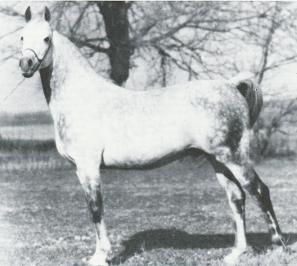
Azraff
(*Raffles X Azja IV)
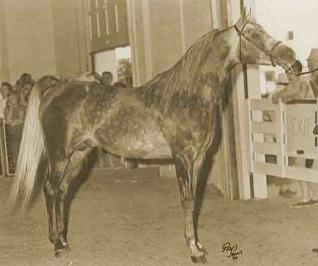
Gay-Rouge
(Azraff X Gay-Rose)
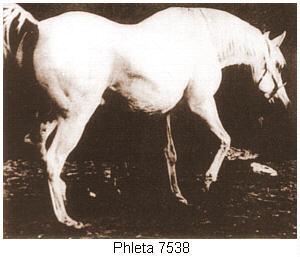
Phleta
(*Raffles X Phala)
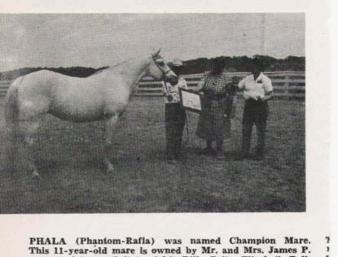
Phala
(Phantom X Rafla)
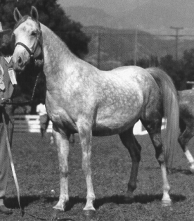
Bint Sahara
(Farawi X Bint Sedjur)
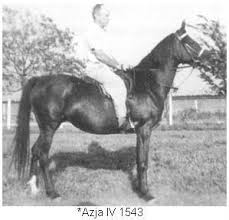
*Azja IV
(LandsKnecht X Asra)
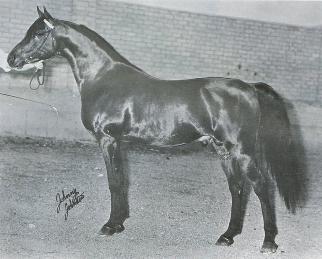
Comar Bay Beau+++
(Azraff X Rose Of Mirage)
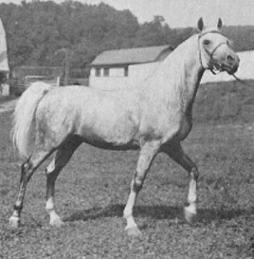
*Raffles
(*Skowronek X *Rifala)
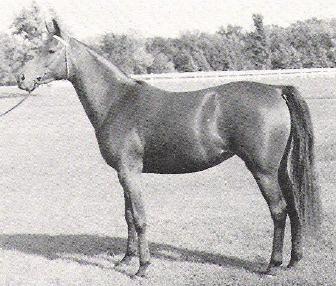
Gay-Rose
(Ferzon X Gali-Rose)
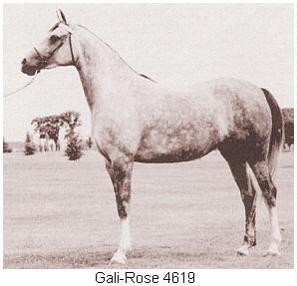
Gali-Rose
(Galimar X Bride Rose)
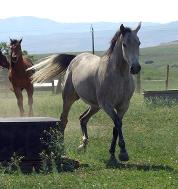
Maur Kemaal
(Arrogaance X Maur Sheba)
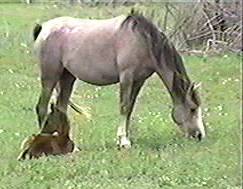
Maur Sheba
(Salil Ibn Sirecho X DB Dhellalah)
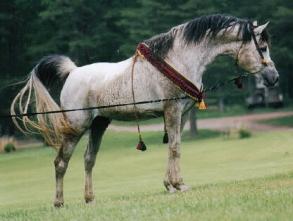
Salil Ibn Sirecho
(Le Encore x Marecho)
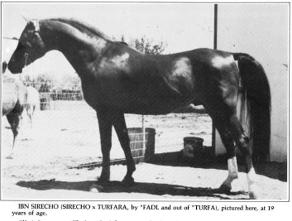
Ibn Sirecho
(Sirecho X Turfara)
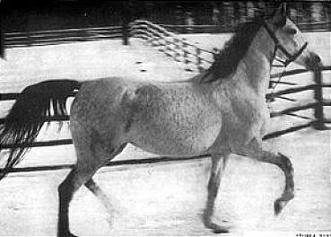
*Turfa
(Desert Bred)
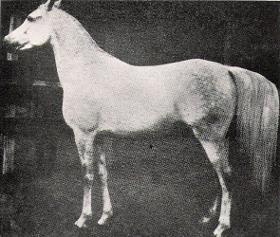
Mahroussa
(Mabrouk Manial X Negma)
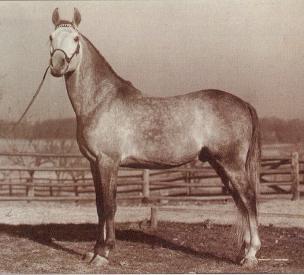
*Fadl
(Ibn Rabdan X Mahroussa)
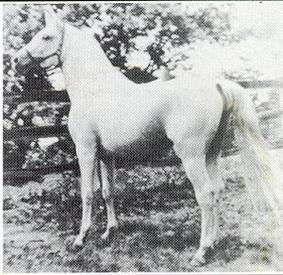
Sirecho
(*Nasr X *Exochorda)
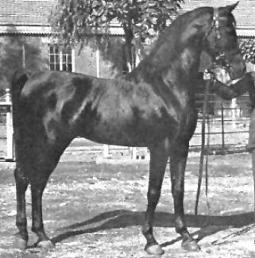
Ibn Rabdan
(Rabdan El Azrak X Bint Gamila)
